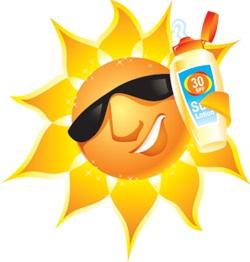Love soaking up those rays? I think we all enjoy getting out in the sun, and taking advantage of all the activities that can go along with it. Some examples include water skiing, picnics, swimming, hiking, linking neighbouring thymine bases through direct covalent bonding… Not familiar with the last one? This is what can happen when our DNA absorbs UV light.
As nice as the glowing effects of prolonged sun exposure may be, the long term and microscopic effects certainly deserve attention too. The specific type of DNA mutation involved with UV light absorption is called induced mutation. This type of mutation is caused by either radiation or environmental chemicals. The specific mutagen of interest in this blog of course being of UV light radiation.
 This is a woman who has stayed in the sun for too long, resulting in a sunburn.
This is a woman who has stayed in the sun for too long, resulting in a sunburn.
Picture from: http://4.bp.blogspot.com/-s9PEOgjLLxM/T8ZEo0B8VbI/AAAAAAAABRE/bHOFTS7lKtE/s1600/Sunburn-794174.gif
DNA typically has no direct covalently bonded base pairs, but as mentioned earlier, exposure to the sun can change this. A covalent bond is when atoms share electrons with one another. When two thymine bases within our DNA covalently bond, it causes complications when the DNA strand tries to replicate. This is bad since since it prevents the body from creating its natural DNA strands. However, since it is expected that we get out into the sun as a part of everyday life, the body possesses enzymes which attempt to solve the damaged DNA replicating problem.
After two thymines have covalently bonded, there are two mechanisms which help to ensure the no DNA mutation will result proceeding the replication process. Light repair and Dark repair can be put to work as long as only one of the two DNA strands has been affected by UV damage. In both cases, the damaged DNA strand will not be used in the replication, only the undamaged strand. These two mechanisms however cannot be employed if both DNA strands have been damaged.
In the worst case scenario, where neither Light repair or Dark repair are applicable, the SOS repair is applied. This will ultimately lead to mutations being produced, but at the same time send SOS response genes to attempt to repair the mutated DNA strands. This is done through insertions and deletions of nucleotides in efforts to restore the DNA strand to its healthy pre-damaged self.
 This is the sun holding sunscreen, something we should all be wearing when the sun is shining.
This is the sun holding sunscreen, something we should all be wearing when the sun is shining.
Picture from: http://www.motherearthnews.com/uploadedImages/Blogs/Healthy_People,_Healthy_Planet/uvsafetymonth.jpg
Although there are efforts which can be made by the body to repair itself after being scorched by the sun, what should really hit home is that this causes harm non the less. So even if it makes us feel like bronzed babes at the time, remember all the repair work we’re setting our bodies out to do. Think long term, and help yourself out by wearing sunscreen, hats, and reducing prolonged UV light exposure.
Chelsea Forbes
References:
SOS Response retrieved on September 30 2012
URL: http://en.wikipedia.org/wiki/SOS_response
(2012). MICB 201: Introductory Environmental Microbiology. Vancouver: Department of Microbiology and Immunology University of British Columbia
Ralph H. Petrucci, William S. Harwood, F. Geoffrey Herring, and Jeffery D. Madura. (2007). General Chemistry: Principles and Modern Applications, Ninth Edition. New Jersey: Prentice-Hall, Inc.


3 responses to “Beat the Heat”